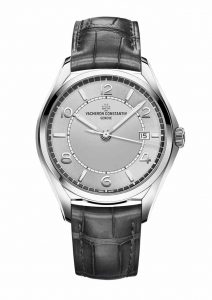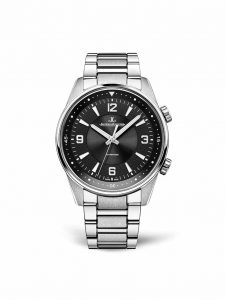
After two years of worrying declines, the high-end watch trade is showing signs of a rebound. At the 28th annual Salon International de la Haute Horlogerie (SIHH), which concludes today in Geneva, a flurry of entirely new collections designed to appeal to millennial buyers raised hopes that 2018 would be a turnaround year for the industry.
“You really feel the energy this year, looking at the booth, at the novelties, at the general mood,” said Laurent Perves, chief marketing officer of Vacheron Constantin, one of 35 brands exhibiting at the prestige watch fair. “We have high expectations for this coming year.”
The 263-year-old watchmaker has staked its reputation on a new collection called FiftySix. Inspired by a midcentury design from the Vacheron Constantin archives, the line of contemporary dress watches opens at $11,700 for a steel model and goes up to $35,000 for a complete calendar wristwatch.
“It remains a very luxurious and high-positioned range but the steel is a fantastic entry point for the next generation of Vacheron connoisseurs,” Perves said.

Vacheron Constantin FiftySix self-winding watch in stainless steel
Jaeger-LeCoultre is employing a similar strategy with its new Polaris collection, which revives the brand’s iconic Memovox Polaris, a 1968 dive watch that has a cult following among collectors. Available in a full range that includes three-hand automatic, chronograph, and world time models, and beginning at $5,600, the sport watch line satisfies demand for what deputy CEO Geoffroy Lefebvre described as “daily use timepieces.”
“This is Jaeger-LeCoultre: We offer the best in style at a competitive price,” he said. “It’s a great value for money.”

Jaeger-LeCoultre Polaris Automatic watch in stainless steel
At Cartier, the big news was the debut of a reinterpreted Santos line. Created in 1904 and named after the famed Brazilian aviator Alberto Santos Dumont, the square-shape watch—designed to evoke the grand boulevards of Paris—now boasts thinner proportions and a bevy of strap options (17 different color choices, to be exact).
A Cartier executive said the watch will be sold online and customers will be encouraged to visit a boutique to have it sized. (Jaeger-LeCoultre went one step further: It offered 68 pieces from the Polaris collection for sale on its website on day one of SIHH, Jan. 15.)
The ease with which executives discussed their e-commerce initiatives was in stark contrast to the attitude of years past, when they widely derided the internet as a breeding ground for dealers of gray market and counterfeit timepieces.
What’s changed? The emergence of a new, more trusted breed of online retailer specializing in preowned timepieces has compelled the big brands to revisit their digital strategies as well as their ideas about the secondary market.
Audemars Piguet chief executive François-Henry Bennahmias confronted the used watch topic head-on at the brand’s press presentation on Jan. 17.
“Preowned, secondhand will become huge,” he said. “The estimate is that it will be roughly 10 times the new watch business. Unlike the car industry, we left it to outsiders so we have to recapture that market. We’re testing [a secondhand concept now]. Fast forward two to three years and we’ll see [our own] preowned boutiques.”
(Top: Photo courtesy of SIHH)
Follow JCK on Instagram: @jckmagazineFollow JCK on Twitter: @jckmagazine
Follow JCK on Facebook: @jckmagazine